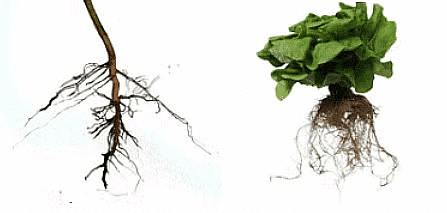Getting to Know Plants Class 6 Worksheet Science Chapter 4
Q1: True/False
(a) All plants are of the same size.
(b) Photosynthesis takes place in the absence of light.
(c) Transpiration and Photosynthesis are the main functions of a leaf.
(d) Roots hold the plant above the soil.
(e) Pistil is the female part of the flower.
Q2: Fill in the blanks
(a) Major parts of plants are the , , , and .
(b) Plants can be classified into three categories: , and .
(c) is the process by which leaves prepare food for the plant.
(d) Two types of roots are and .
(e) is the male part of the flower.
Q3: What are ovules?
Q4: Name two flowers with joined petals.
Q5: Name two flowers with joined sepals.
Q6: Name two flowers with separated sepals.
Q7: From where do potatoes get the starch?
Q8: How are leaves attached to the stem?
Q9: Write 5 examples of edible roots.
Q10: The following picture shows two types of roots. Write the type of roots for the following figures.
Q11: How do plants exchange gases with the environment?
Q12: Do the flowers with joined sepals have petals that are separate or are they joined together?
Q13: Do the flowers with joined petals have stamen joined to the petal?
Q14: What type of roots the plants with parallel venation in the leaves likely to have?
Q15: How stem is like a two way street?
Q16: Do all the leaves have petioles?
Q17: What are the functions of the petals and sepals in flowers?
Q18: What does the ovary convert into after maturation?
Q19: Why is it difficult to separate the sprouted young plants from the cotton wool?
Q20: What are trees? Give two examples of trees.
Assertion and Reason Questions
Q21: Assertion (A): Plants release a lot of water into the air through the process of transpiration.
Reason (R): The water is released through the leaves in the form of water vapour.
(a) Both A and R are true and R is the correct explanation of A.
(b) Both A and R are true but R is not the correct explanation of A.
(c) A is true but R is false.
(d) A is false but R is true.
Q22: Assertion (A): Trees are plants which are very tall. They have a hard and thick brown stem.
Reason (R): Lamina is thin, flat, broad, green part of leaf.
(a) Both A and R are true and R is the correct explanation of A.
(b) Both A and R are true but R is not the correct explanation of A.
(c) A is true but R is false.
(d) A is false but R is true.
Q23: Assertion (A): The minerals dissolved in water move up in stem along with water.
Reason (R): The stem bears leaves, flowers and fruits.
(a) Both A and R are true and R is the correct explanation of A.
(b) Both A and R are true but R is not the correct explanation of A.
(c) A is true but R is false.
(d) A is false but R is true.
Q24: Assertion (A): The parts of a typical flower are sepals and petals only.
Reason (R): The parts of stamen are filament and anther.
(a) Both A and R are true and R is the correct explanation of A.
(b) Both A and R are true but R is not the correct explanation of A.
(c) A is true but R is false.
(d) A is false but R is true.
Q25: Assertion (A): Leaves with reticulate venation typically have taproots.
Reason (R): The pattern of veins in leaves is related to the type of roots a plant has.
(a) Both A and R are true and R is the correct explanation of A.
(b) Both A and R are true but R is not the correct explanation of A.
(c) A is true but R is false.
(d) A is false but R is true.
Multiple Choice Questions (MCQs)
Q26: Which of the following parts of a plant is primarily responsible for photosynthesis?
(a) Root
(b) Stem
(c) Leaf
(d) Flower
Q27: What is the function of the root in a plant?
(a) Absorb water and minerals
(b) Perform photosynthesis
(c) Produce flowers
(d) Release oxygen
Q28: Which type of roots do plants with parallel venation in their leaves typically have?
(a) Tap roots
(b) Fibrous roots
(c) Prop roots
(d) Aerial roots
Q29: What is the process by which water is lost from the leaves of a plant?
(a) Photosynthesis
(b) Transpiration
(c) Respiration
(d) Germination
Q30: Which part of a flower produces pollen?
(a) Petal
(b) Sepal
(c) Stamen
(d) Pistil
You can access the solutions to this worksheet here.
FAQs on Getting to Know Plants Class 6 Worksheet Science Chapter 4
| 1. How do plants obtain energy from the sun? |  |
| 2. What is the role of roots in plant growth? |  |
| 3. How do plants reproduce? |  |
| 4. What are the different parts of a plant and their functions? |  |
| 5. How do plants adapt to their environment? |  |























